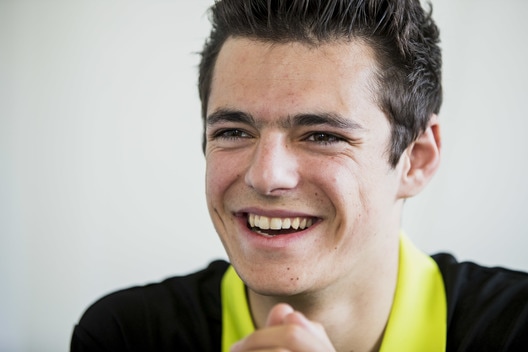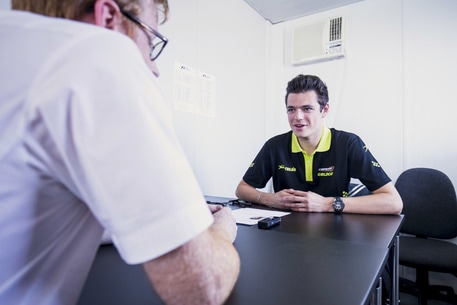 Julien Falchero has a new way to work, with a little help from a friend Most people think that the only thing you need to be a successful racer is speed. If a kid has speed, the saying goes, then the rest can be learnt: you can’t learn speed. We’ve all heard this saying, maybe you’ve even said it. But what if it’s wrong? What is speed isn’t all you need? Julien Falchero came to racing relatively late, compared to his rivals: “it’s the beginning of just my third season in single seaters,” the Frenchman confirms, “and before this I only did 2 years of karting, so I started motorsport quite late at 16 years old.” And he’s fast – even a cursory look at his testing results would confirm that – but he knew there was more to being a successful driver than just speed. A lot of drivers hire driver coaches, older drivers who have been through the wringer and come out the other side, and they are a great source of information and advice on how to push their career forward. There are plenty of current drivers in other championships who make a decent living on the side helping their charges to improve: it’s a well-established part of the industry. But what Falchero did was different. Instead of hiring a twenty something hot shoe, he decided to work with a 70 year old Frenchman who has raced for 8 Formula 1 teams. He decided to work with Jean-Pierre Jarier. How on earth did that come about? “Well, he’s a friend of mine!” Falchero laughs. “I’ve known him for a while, and last year I drove at Monaco and I told him that I needed somewhere for my sponsors to go to see the race: he helped with that, and we met again there and talked.” Something about the chat inspired the French legend. “He decided to look more at the end of my season last year, and then this season he said he wanted to be with me, and to help me for the season in GP3.” So not a case of choosing a driver coach: Jarier chose him. But what does the elder man bring to the table? “Oh, a lot of things. He gives me a lot of tools: how I have to be as a driver, changing my view from inside the car and outside of the car, some special tools that only an F1 driver knows. “I have some other people [who help] for the mental side, and for the physical coaching. But he helps me a lot with communications, for example, and I need him for on the track because I don’t have a lot of experience. So he helps me a lot to be more aggressive, some tools that are very important and that I need on the track, so it’s really important.” It’s likely that some of Jarier’s team members from his F1 days would raise a wry smile at that, considering how famously sharp-tongued the Frenchman could be when he felt that the car wasn’t right (this is the man who was fired after an argument with his ATS team manager in Monaco, and was re-hired in Germany before walking out once again, after all). But perhaps he’s mellowed over the years: certainly Falchero thinks he has been instrumental in improving communication within the Campos truck. “I think my view outside of the car, when I discuss with the engineers, is much better,” he confirms. “Before when I was talking with my engineer I was starting to say some bad things or I wasn’t using the right words, and he helped me with that: he explained to me that it was really important to have a good relationship with my engineer, and that I needed to be really clear with him, because sometimes you don’t have a lot of time and you need to take a very fast decision. “He helps me a lot, and I think it’s very important because if you look, for example, at GP3 in free practice we have one run, we go to the box, we have another run, and when we go to the box I need to explain very fast, but very clearly, to my engineer what’s happened on the car. Before I was thinking it’s not very important, but he has helped me to see better, to give me the words to use, very clear words, and not to talk about stupid things that my engineer is not interested in!” But how does it work, in practice? Some teams take a dim view on having another driver sitting in, listening to all of their hard-earned information, but Jarier is not the usual ex-driver. And team boss Adrian Campos having a similar career probably doesn’t hurt: “yeah, when I said to Adrian that I would work with Jean-Pierre Jarier he was very happy, because it’s not all the time that you have an ex-Formula 1 driver with you! “We work very close together, and with the team also: the team is very happy that he’s here because he knows a lot of things from Formula 1, and all the time it’s a good advantage for the team. But sometimes he knows that he needs to step back, and at other points he knows that he can help. We work together, and it’s a good team.” And it doesn’t hurt on the sponsorship side either: “Yeah, this is why he helps me so much on communication. I was not very famous before coming to GP3, but now with him my communications are much better in France, it’s better for the sponsors and everything. We are very close, and am really happy about this.” So Jarier helps with communications within the team, when time is tight, and also out of the car when he needs to sell his results to the public, and to the sponsors who allow him to be here racing. But that’s not the best part of working so closely with a legend (and driving for another one). No, the best part is when you leave the track with his mentor and his boss: “Yeah! It’s very interesting when you’re at dinner, and they tell you all the old stories from Formula 1: it’s really amazing!” If life is a lesson, then Julien Falchero is clearly enjoying every part of his education.
0 Comments
Leave a Reply. |
AuthorWrite something about yourself. No need to be fancy, just an overview. Archives
November 2017
Categories |

 RSS Feed
RSS Feed